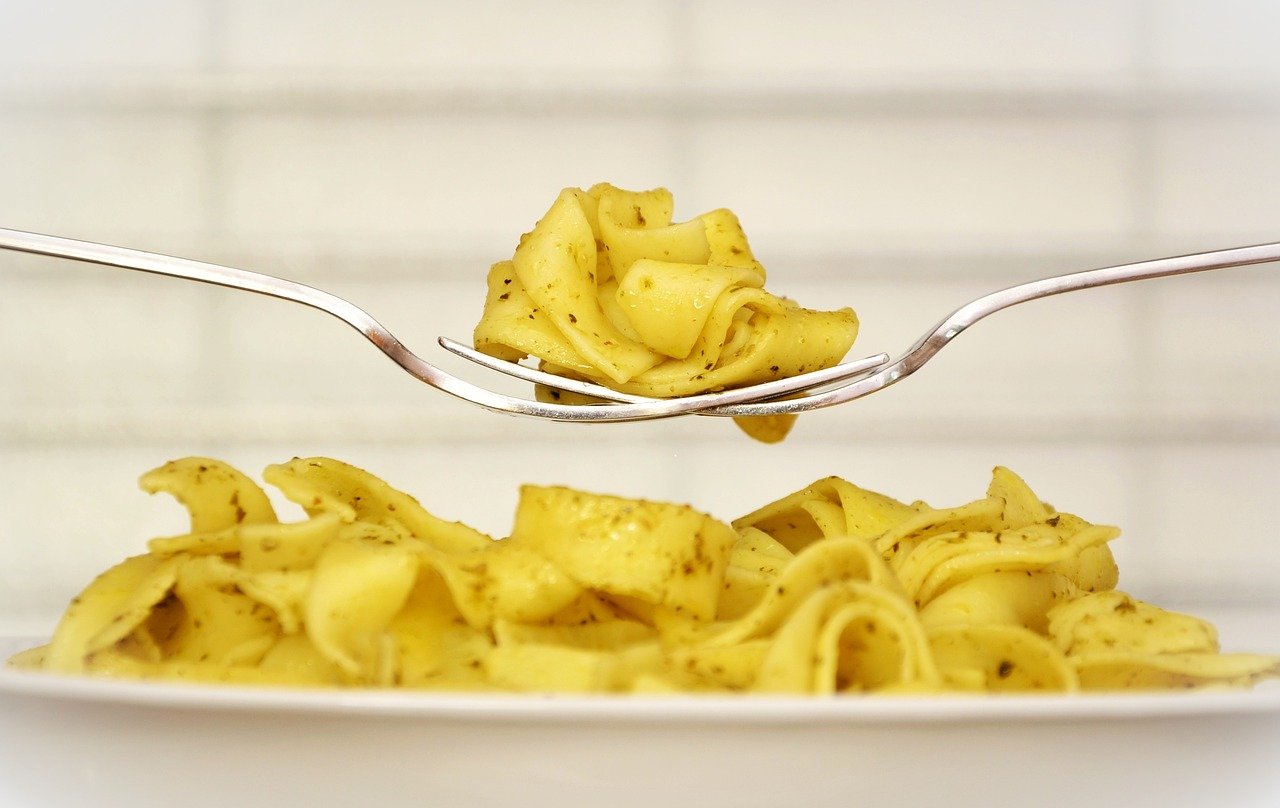
“Is pasta healthy? ” is a question many ask, especially when faced with a delightful plate of spaghetti Bolognese or creamy fettuccine Alfredo.
Pasta, undeniably delicious and fulfilling, has been scrutinized under the lens of low-carb diets and the debate on processed foods’ health effects.
This leaves many pondering whether pasta retains its place in a balanced and nutritious diet.
So, let’s dish and explore the question: is pasta healthy for you?
Is Pasta Healthy? The Nutritional Breakdown of Pasta
Pasta has long been a beloved comfort food, but it’s important to understand its nutritional value to determine if it can truly be a healthy addition to your diet.
Let’s dive into the nutritional breakdown of pasta and see how it stacks up.
First off, pasta is primarily made up of carbohydrates. Carbs often get a bad rap, especially when it comes to weight gain and blood sugar control.
However, not all carbs are created equal. Pasta contains complex carbohydrates, which are a more nutritious form of this macronutrient.
These complex carbs break down more slowly in the body, providing a steady source of energy and helping to keep you feeling fuller for longer.
In terms of calories, a 2-ounce serving of cooked pasta typically contains around 200-220 calories. While this may seem high, it’s important to consider portion sizes.
Two ounces of pasta is a reasonable serving and can easily be balanced with other nutrient-dense ingredients.
When it comes to protein, pasta falls short. It typically contains only about 6 grams of protein per serving. However, you can easily boost the protein content of your pasta dish by adding lean sources of protein such as chicken, shrimp, or tofu.
This not only increases the nutritional value but also helps to make the meal more satisfying.
Pasta is also a good source of essential minerals like iron and folate. Iron is important for oxygen transport in the body and folate plays a crucial role in cell division and growth.
Additionally, pasta contains some B-vitamins and fiber, although the amount can vary depending on the type of pasta.
Another consideration when evaluating the nutritional breakdown of pasta is the glycemic index (GI). The GI is a measure of how quickly a carbohydrate-rich food raises blood sugar levels.
Pasta has a moderate GI, meaning it doesn’t cause a sharp spike in blood sugar.
However, if you have diabetes or are following a low-carb diet, it’s still important to monitor your portion sizes and choose whole grain options, as these have a lower GI and provide more fiber.
In summary, pasta can be a part of a healthy diet when consumed in moderation and balanced with other nutrient-rich ingredients.
It’s important to be mindful of portion sizes, choose whole grain options when possible, and add protein and vegetables to make it a well-rounded meal.
So, go ahead and enjoy your favorite pasta dishes knowing that they can be a nutritious and satisfying addition to your diet.
Unmasking the Myths About Pasta

When it comes to pasta, there are plenty of myths floating around about its impact on our health. Let’s dive in and uncover the truth behind these myths about pasta.
1. Enemy of Weight Loss
One common myth is that pasta is the enemy of weight loss. Many people believe that cutting out pasta is necessary for shedding pounds.
However, the key to weight loss is not eliminating an entire food group, but rather practicing moderation and making mindful choices. Pasta can absolutely be a part of a weight loss journey, as long as it’s consumed in appropriate portion sizes and balanced with other nutrient-rich ingredients.
In fact, studies have shown that pasta can be included in a healthy Mediterranean-style diet, which is associated with numerous health benefits, including weight management.
2. High-Calorie Food
Another myth is that pasta is a high-calorie food. While it’s true that pasta does contain calories, the key is to be mindful of portion sizes.
A 2-ounce serving of cooked pasta typically contains around 200-220 calories, which is reasonable when considering the overall nutritional value it provides.
It’s important to remember that a well-rounded meal includes more than just pasta, so balancing it with lean sources of protein, vegetables, and healthy fats can create a satisfying and nutritious meal.

3. Lacks Nutrients
Some people wrongly believe that pasta is nutritionally void and offers no health benefits.
Pasta is a good source of essential minerals like iron and folate, which play important roles in our overall health. It also contains some B-vitamins and fiber, although the amount can vary depending on the type of pasta.
While it’s true that pasta is primarily a carbohydrate-based food, it offers complex carbohydrates that break down more slowly in the body, providing a steady source of energy and helping to keep us feeling fuller for longer.
4. Not Suitable for Diabetics
Lastly, there is a misconception that pasta is not suitable for individuals with diabetes or those following a low-carb diet. While it’s true that portion sizes and the type of pasta should be taken into consideration, pasta can still be enjoyed in moderation.
Opting for whole grain varieties, which have a lower glycemic index and provide more fiber, can be a smart choice for individuals with diabetes or those looking to manage their blood sugar levels.

The Role of Pasta in a Balanced Diet
Pasta has often been labeled as a carb-heavy, indulgent food that should be avoided in a healthy diet. But is this really the case? Can pasta play a role in a balanced diet?
Let’s dive in and explore the role of pasta in a nutritious eating plan.
Balance
First and foremost, it’s important to recognize that balance is key in any healthy diet.
While it’s true that pasta is primarily a carbohydrate-based food, it can still be part of a well-rounded meal when consumed in moderation and paired with nutrient-rich ingredients.
The key is to make mindful choices and practice portion control.
When incorporating pasta into a balanced diet, it’s important to consider the other components of the meal. For example, adding lean sources of protein such as grilled chicken, shrimp, or tofu can help to balance out the meal and provide essential amino acids for muscle repair and growth.
Including plenty of vegetables, such as broccoli, spinach, or bell peppers, can also add vital nutrients and fiber to the meal.
Finally, incorporating healthy fats like olive oil or avocado can provide satiety and contribute to a well-rounded eating plan.
High Energy Food
Pasta can also be a great option for athletes or individuals with high energy needs.
Its carbohydrate content provides a readily available source of energy, making it an excellent choice for fueling physical activity. Athletes often rely on pasta as a pre-competition meal to ensure optimal glycogen stores and enhance performance.

Varying Nutritional Value
It’s worth mentioning that pasta varieties can vary significantly in terms of nutritional value. Whole grain pasta, for example, is a healthier choice compared to refined pasta.
Whole grain pasta contains more fiber, vitamins, and minerals compared to its refined counterpart. Fiber is particularly important for digestive health and can help to keep us feeling full and satisfied.
Choosing whole grain pasta can provide additional health benefits and contribute to a balanced diet.
Pasta Varieties: Whole Grain vs. Refined Pasta
When it comes to choosing pasta, there are various options available on the market.
One important distinction to consider is whether you should opt for whole grain pasta or refined pasta.
So, let’s dive into the debate and explore the differences between these two pasta varieties.
Whole Grain Pasta
Whole grain pasta is made from whole wheat flour, which means it contains all parts of the grain.
This makes it a more nutritious choice compared to refined pasta. Whole grain pasta is higher in fiber, vitamins, and minerals compared to its refined counterpart.
Fiber is particularly important for digestive health, as it helps to regulate bowel movements and maintain a healthy gut.
Additionally, the fiber content in whole grain pasta can help you feel full and satisfied.

Refined Pasta
On the other hand, refined pasta is made from wheat flour that has had the bran and germ taken out.
This process strips away much of the fiber and nutrients, making refined pasta less nutritious than whole grain pasta. Refined pasta also tends to have a higher glycemic index (GI), meaning it raises blood sugar levels more rapidly.
However, it’s important to note that portion control and pairing refined pasta with protein and fiber-rich ingredients can still make it a part of a balanced diet.
Taste and Texture
When it comes to taste and texture, whole grain pasta does have a slightly nuttier flavor and a chewier texture compared to refined pasta.
This can take some getting used to if you’re accustomed to the smoother texture of refined pasta. However, with a little creativity in the kitchen and the right combination of ingredients, whole grain pasta can be just as delicious and satisfying as its refined counterpart.
So, which pasta variety should you choose?
Ultimately, the decision depends on your personal preferences and health goals.
If you’re looking to increase your fiber intake and incorporate more whole foods into your diet, whole grain pasta is the way to go. It offers a range of health benefits and can be a great addition to a balanced eating plan.
However, if you prefer the taste and texture of refined pasta, there’s no need to eliminate it entirely. Just remember to practice portion control, pair it with protein and vegetables, and balance it with other nutrient-rich ingredients.
In summary, when it comes to pasta varieties, whole grain pasta is the healthier choice.
However, refined pasta can still be enjoyed in moderation and as part of a well-rounded meal.
Incorporating Pasta into a Healthy Eating Plan
Pasta lovers rejoice!
You can still enjoy your favorite carb-filled dish while maintaining a healthy eating plan.
Incorporating pasta into a balanced diet is all about making mindful choices and being aware of portion sizes.
So, let’s dive in and explore how you can include pasta in a nutritious eating plan.
Portion Control
First and foremost, it’s important to remember that balance is key.
Pasta may be a carbohydrate-rich food, but it can still be part of a well-rounded meal when consumed in moderation. The key is to focus on portion control and pair pasta with nutrient-rich ingredients.
Instead of loading up your plate with a heaping mound of pasta, aim for a serving size of about 2 ounces. This allows you to enjoy your favorite pasta dishes without going overboard on the carbs.
Incorporate Protein
When it comes to balancing your pasta meal, don’t forget to incorporate protein.
Adding lean sources of protein, such as grilled chicken, shrimp, or tofu, can help to create a more satisfying and nutritious dish.
Protein is essential for muscle repair and growth, so including it in your pasta meal can help you feel fuller for longer and support your overall health and fitness goals.

Vegetables
Vegetables are another important component to consider when incorporating pasta into a healthy eating plan.
Adding a variety of colorful vegetables, such as broccoli, spinach, or bell peppers, can provide vital nutrients, fiber, and antioxidants.
Vegetables not only add volume and flavor to your pasta dish but also contribute to feelings of satiety and overall well-being.
Healthy Fats
Lastly, don’t forget about healthy fats. Including sources of healthy fats, such as olive oil or avocado, in your pasta meal can provide additional satiety and flavor.
Healthy fats are important for nutrient absorption, hormone production, and overall brain health.
Plus, they add a delicious richness to your pasta dishes that can elevate the flavors and make them even more satisfying.
Incorporating pasta into a healthy eating plan doesn’t have to be complicated or restrictive. By practicing portion control, balancing it with protein and vegetables, and incorporating healthy fats, you can create a well-rounded and satisfying meal.
So, go ahead and enjoy your pasta dishes with the confidence that they can fit into a nutritious eating plan.
Remember, it’s all about balance and making choices that support your overall health and well-being.
10 Healthy Pasta Recipes You Need to Try 🍝🥗
Pasta can be both delicious and nutritious when made with the right ingredients! Here are 10 healthy pasta recipes that fit into a balanced diet:
1. Easy Chicken Parmesan Pasta 🍗🧀
A lighter version of the classic! Use whole wheat pasta, lean grilled chicken, and homemade marinara sauce. Top with a sprinkle of Parmesan and fresh basil.
2. Meal Prep Protein Pasta 🍱💪
Cook whole wheat pasta with ground turkey, spinach, and a light tomato sauce. Divide into meal prep containers for an easy high-protein meal all week!
3. Creamy Avocado Pasta 🥑🍋
Blend avocado, garlic, lemon juice, and olive oil into a creamy sauce. Toss with whole wheat spaghetti and cherry tomatoes for a fresh, plant-based meal.
4. Pesto Chickpea Pasta 🌿🧄
Swap traditional pasta for chickpea pasta for extra protein. Mix with basil pesto, roasted veggies, and a handful of pine nuts for a nutrient-dense meal.
5. Mediterranean Pasta Salad 🥗🍅
Combine whole wheat pasta, cucumbers, olives, feta cheese, and cherry tomatoes with a zesty lemon dressing. Perfect for meal prep or a light dinner!
6. High-Protein Turkey Bolognese 🍲🦃
Simmer lean ground turkey in a rich tomato sauce with garlic and onions. Serve over whole wheat pasta for a protein-packed dinner.
7. Dairy-Free Alfredo with Zucchini Noodles 🥒🌱
Blend cashews, garlic, and nutritional yeast for a creamy, dairy-free Alfredo sauce. Serve over zucchini noodles or whole wheat pasta.
8. Sheet Pan Chicken & Veggie Pasta 🍗🥕
Roast chicken breast, bell peppers, and cherry tomatoes on a sheet pan. Toss with whole grain pasta and a drizzle of olive oil for an easy dinner.
9. Spicy Shrimp & Garlic Pasta 🍤🌶️
Sauté shrimp with garlic, red pepper flakes, and olive oil. Toss with whole wheat pasta and fresh parsley for a light but flavorful dish.
10. Roasted Vegetable & Quinoa Pasta 🍆🥬
Combine roasted eggplant, zucchini, and bell peppers with quinoa pasta for a gluten-free and fiber-rich meal. Drizzle with balsamic glaze for extra flavor!
✨ Want more easy, healthy recipes? Click here to explore nutritious meal ideas! https://craveworthynutrition.com/10-easy-pasta-recipes-restaurant-like
Related Articles:
Exploring the Flavors of Thailand: A Guide to Authentic Thai Spring Rolls
Unveiling the Secret of The Gigi Hadid Pasta Love
As an Amazon Associate, I earn commission from qualifying purchases.





